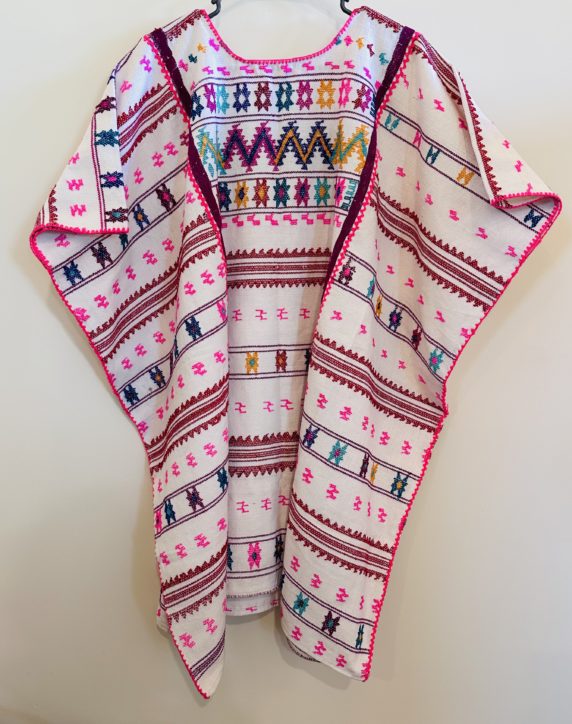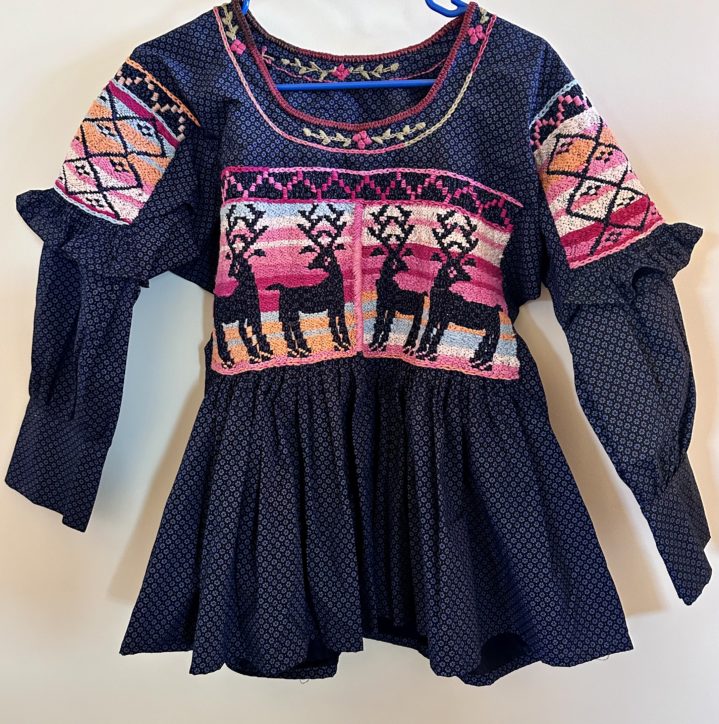I’m down to two boxes and half-a-closet of textiles and I want to sell them all before I move from North Carolina to New Mexico. These are new, never worn or used, bought from artisans whose work I admire, respect and wanted to support. Often, along the way and through the years, I bought just to support them and know that someone out there — like you — would appreciate the workmanship as much as I do. I usually don’t bargain hunt nor do I haggle on the price. I look for quality of cloth, weaving, embroidery and color. Quality is so spectacular and prices so fair based on time to create, that I considered it an honor to purchase these pieces.
Lots to choose from: 43 pieces.


Alberto Gomez Lopez is a talented young designer from the Chiapas village of Magdalena Aldama in the Chiapas highlands about 2 hours beyond San Cristobal de las Casas. In January 2020 he was invited to New York Fashion Week, showcasing the back strap loom weaving of his family cooperative.
To Buy: Please email me normahawthorne@mac.com with your name, mailing address and item number. I will mark it SOLD, send you a PayPal link to purchase and add $12 for cost of mailing. Please DO NOT SELECT buying goods or services — so we don’t pay commissions. We also accept Venmo and Zelle. I can send you a Square invoice (+3% fee) if you don’t use PayPal. All sales final.
Some of these pieces I ordered especially for resale to help artisans I know who are struggling to earn enough to feed their families. Your purchases will send money back to Mexico for them.

Luis Rodriguez is one of the foremost ikat weavers of Tenancingo de Degollado, Estado de Mexico. Click on THIS LINK to see a video of his work. This is a full length, wide shawl, ample enough to wrap around your shoulders twice with comfort. The punta — fringes — are especially long and intricate. This piece came from his workshop-studio.



Francisca lives and works in a one-room concrete block house in Aguacatenango, Chiapas, with her husband and daughter. We discovered her about four years ago when we visited the village. Her workmanship is the best embroidery I have ever seen — dense, perfect French knots.

The Las Sanjuaneras cooperative is one of the most creative and innovative in the State of Oaxaca. They live and work in a small village, San Juan Colorado, in the highlands off the Coast of Oaxaca. They work only in cotton with natural dyes that they make themselves. It can take six to eight months to weave an exceptional collector’s huipil like the one above. Someone! Please purchase these pieces so I can send funds to the weavers!




Yezi in Xochistlahuaca, Guerrero, an Amusgo village, sent pieces to me to sell for her cooperative. They are remote and have little opportunity to market their pieces. This is a special GALA huipil woven and worn for special occasions. Please support what they do!


The Palafox family are the premier weavers in the coastal village of San Mateo del Mar. They were devastated by the recent earthquake. This is a VERY FINE back-strap loom woven huipil dyed with indigo. Figures include crabs, palm trees, deer, fish — life at the beach!

Warm enough for winter, this poncho is double-woven and glorious.



This piece is woven by Jorge Isidro’s mother. Where is San Felipe Usila? Between Veracruz and Oaxaca, high in the mountains, a 12-hour bus ride from Oaxaca City. Pieces like this are selling for upwards of $700 in the city.


To Buy: Please email me normahawthorne@mac.com with your name, mailing address and item number. I will mark it SOLD, send you a PayPal link to purchase and add $12 for cost of mailing. Please DO NOT SELECT buying goods or services — so we don’t pay commissions. We also accept Venmo and Zelle. I can send you a Square invoice (+3% fee) if you don’t use PayPal. All sales final.

I’ve marked this piece down to sell. It is gorgeous, soft and luxurious native Oaxaca cotton.



Finest, softest cotton with intricate embroidery from Jolom Mayetik Cooperative.


Aldama Magdalenas is a Maya village almost three hours from San Cristobal de las Casas. We visit the cooperative formed by Rosa and Cristobal during our Chiapas Textile Tour. This is a traditional village that depends on weaving and subsistence farming.


The ruana is a garment that is like a poncho, but open in the front. You can wear this as shown, or wrap the front flaps around your shoulders. Open on both sides.

Measures 10″ high x 13″ wide. Bii Dauu has been working in natural dyes for over 25 years in Teotitlan del Valle. The work is exceptional. This bag has a zipper and is lined with an inside zip pocket.

A great shoulder bag for toting accessories, make-up or travel documents. Amazing embroidery on natural combed sheep wool.

Erasto “Tito” Mendoza wove this bag for me many years ago. The Mendoza family of Teotitlan del Valle is known for their outstanding craftsmanship. It’s been in my collection for years. I still have a couple others! You may recognize the weaving style. Tito is the first cousin of famed Arnulfo Mendoza who passed a few years ago.


This is a traditional style from the Oaxaca coast created on the back strap loom and then embellished with embroidery. Fun, funky wearable art.

This is the village that makes the Oaxaca wedding dress! The blouse features finest embroidery of birds, pansies, and flowers. Deshillado is the pulled thread openwork treatment — a complex, intricate process.

This textile is from the famous cooperative Sna Jolobil founded by Chip Morris and Pedro Meza. It’s priced at far less than what I paid for it.


These market bags are made from natural plant fiber. The leather straps are adjustable. A perfect expandable bag to go anywhere and hold anything. They are hand-woven by one of the few remaining old men who do this type of work. It takes about 3 months to weave.
To Buy: Please email me normahawthorne@mac.com with your name, mailing address and item number. I will mark it SOLD, send you a PayPal link to purchase and add $12 for cost of mailing. Please DO NOT SELECT buying goods or services — so we don’t pay commissions. We also accept Venmo and Zelle. I can send you a Square invoice (+3% fee) if you don’t use PayPal. All sales final.






























2017 Feria del Carrizo: Oaxaca’s Handwoven River Reed Basket Fair
Join the celebration in San Juan Guelavia
It’s that time of year again, the end of January and early February, when the river reed weavers of San Juan Guelavia hold their annual fair. The event, now in its sixth year, is more than a show and sale of great baskets.
January 29-February 5, 2017
It’s a food fest beyond imagination! You’ll find lots of tamales, chicken mole, goat barbecue, beer, artisanal mezcal, cookies and cakes there, too, to eat and enjoy. Everything is home made! Safe and clean to eat.
Need a guide? Use Sheri Brautigam’s Textile Fiestas of Mexico to take you there! I introduced Sheri to the Feria last year and she made it a chapter with photos.
Here is the weekly line-up.
Event Program, Feria del Carrizo, San Juan Guelavia
Past Oaxaca Cultural Navigator posts about the Feria del Carrizo. Delve into discussion and photos of baskets, people, food, culture, history.
Like this:
3 Comments
Posted in Cultural Commentary, Oaxaca Mexico art and culture
Tagged 2017, baskets, fair, Feria del Carrizo, festival, folk art, hand woven, Mexico, Oaxaca, river reed, San Juan Guelavia